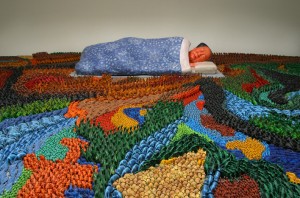« Reviews
Half Life of a Dream: Contemporary Chinese Art from The Logan Collection

Sui Jianguo, The Sleep of Reason (detail), 2005; painted fiberglass and 20,000 toy dinosaurs, dimensions variable; Collection of Vicki and Kent Logan; photo: Kaz Tsuruta, courtesy Asian Art Museum of San Francisco; © Sui Jianguo and Asian Art Museum of San Francisco.
San Francisco Museum of Modern Art
July 10 - October 5, 2008
By Raisa Clavijo
“Half Life of a Dream” on view at SFMOMA through October 5, was comprised of a selection from the Vicki and Kent Logan collection of contemporary Chinese art, perhaps the most important collection of its kind in the United States. Many of the pieces presented on this occasion were donated by the Logans over the past few years to the Denver Art Museum and SFMOMA.
This curatorial project seeks to delve into the psyche and heart of post-Maoist China, taking a key element as its pivotal theme: the realization of individual dreams and goals in juxtaposition to the collective social plan advocated by the State. The assembled artists reveal a wide spectrum of responses to the Nation’s unified plan. The exhibition reflects on unresolved personal trauma hidden behind the still latent utopia of Chinese daily life.
The Chinese art of the last few decades has been characterized as being a reaction to growing consumerism, political repression and the persistence of totalitarian social models. From a formal point of view, the exhibited works evidence the accelerated transition from traditionalistic language to Postmodernism; this had to be assimilated in large doses. The works constitute a kind of ironic smirk at the stale academicism of Socialist Realism, false patriotism and empty political slogans.
Perhaps, the most emblematic piece in the show is “The Sleep of Reason” (2005), by Sui Jianguo. This enormous installation presents a fiberglass sculpture of Mao Zedong sleeping peacefully on a map of Asia constructed using 20,000 multicolored toy dinosaurs. The title immediately calls to mind Goya’s engraving, “El sueño de la razón produce monstruos” (The sleep of reason produces monsters) and symbolically portrays the sleep of the supreme Chinese leader as being a chaotic state of creativity and destruction.
For its part, “100 Chinese” (2001), by Zhang Dali displays the synthetic-resin molded heads of migrant workers who each day arrive in Beijing from the countryside seeking a better life. They represent an anonymous floating population not included in official statistics. Their faces denote a passive resignation when faced with the loss of personal identity in the context of massive human displacement.
Zhang Xiaogang presented pieces from his Big Family series. Since the 90s, this oeuvre has been among the most prized by international collectors of Chinese art. They are paintings inspired by traditional Chinese family portraits and the iconography characteristic of the Cultural Revolution. During this period the traditional concept of the family nucleus as a group of blood relatives, so important within the Chinese context, was displaced by the concept of a social group united by political ideology. Zhang Xiaogang’s portraits show us groups of individuals dressed similarly, with the same facial expressions, and, above all, the same terror in their eyes. It is a standardized portrait of a Nation, the face that China displayed to the outside world.
“Half Life of a Dream” sheds light on the contradictions of a complex political, social and cultural environment. Even if Mao’s totalitarian specter can still find resonance in it, it is losing ground in the face of growing economic capitalization and the ever-increasing emergence of the individual along with his personal aspirations.
Filed Under: Reviews


































